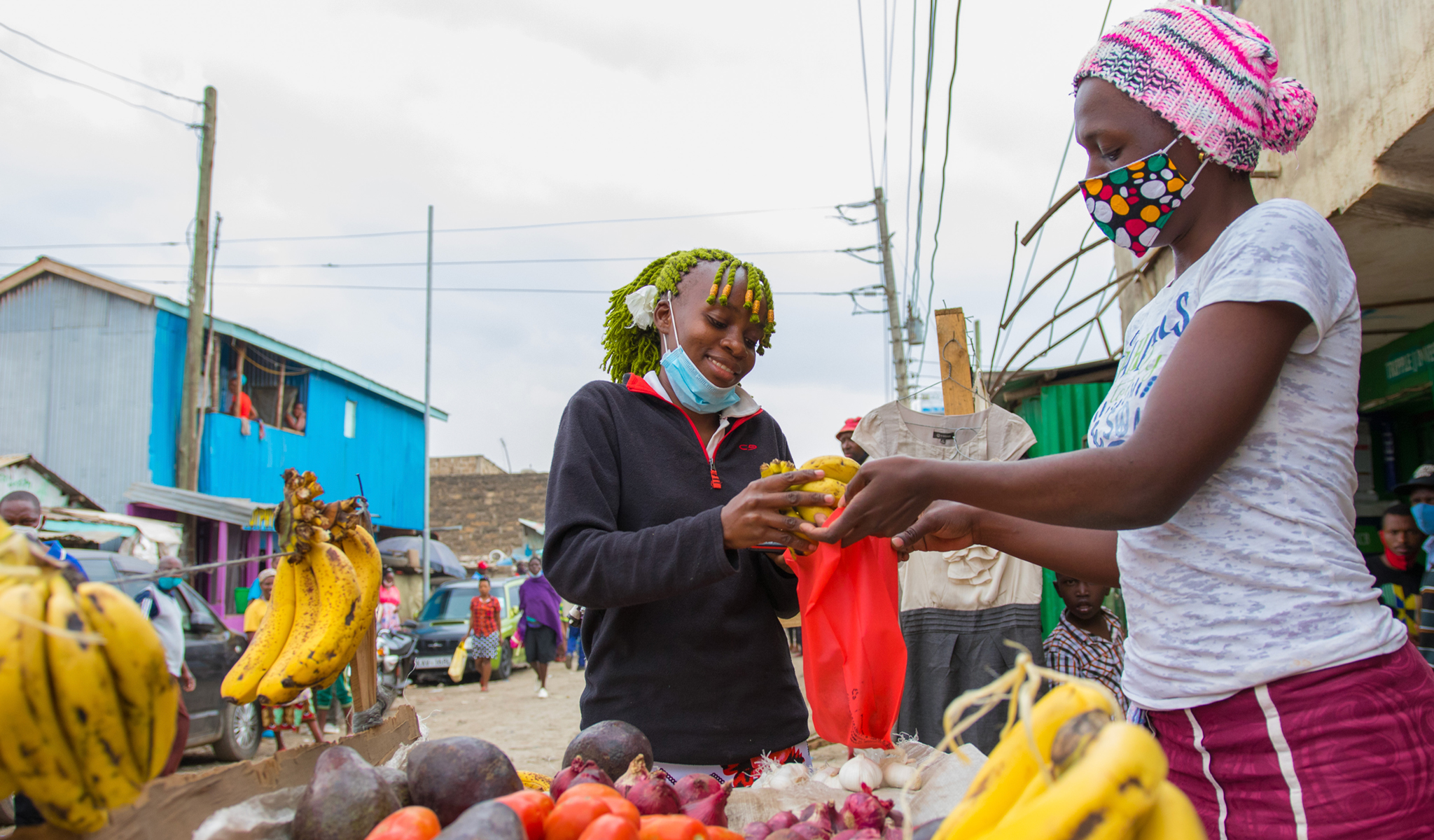Improving the accessibility and affordability of nutritious and safe diets is critical to reducing the global burden of malnutrition.
Use this web page to explore how we can strengthen food systems to improve diets and locate resources to guide your work. Get to know these resources organized by key components of the food system.
For additional information on food systems, and more details about the resources outlined on this page, read this Food Systems Technical Brief.

Using food systems to guide our actions and improve diet and nutrition outcomes.
Household actions alone are insufficient to sustainably reduce malnutrition. Well-considered interventions within the food system can enable household-level actions to improve diets and nutrition through women’s empowerment, agricultural production, and income generation.
Using food systems to guide our actions and improve diet and nutrition outcomes.
Household actions alone are insufficient to sustainably reduce malnutrition. Well-considered interventions within the food system can enable household-level actions to improve diets and nutrition through women’s empowerment, agricultural production, and income generation.

The food system comprises the interrelated parts of a food’s journey from farm to table. To understand how best to improve diet quality and address malnutrition, we need to consider the system as a whole: the actors, their interrelationships and the incentives that affect them.

The RFS Food Systems Conceptual Framework
This document walks through each component of the Bureau for Resilience and Food Security's (RFS) conceptual framework so that users can better understand the components of a food system and how to apply the framework to program design.

How to Use the Resilience and Food Security (RFS) Food Systems Conceptual Framework
This interactive presentation (Prezi) will stimulate thinking and conversations around the RFS Conceptual Framework, encourage independent and group exploration, and support “systems thinking.”
How to take action in the food system
USAID Advancing Nutrition developed a set of resources and tools to help USAID and partners put a food systems approach into action. These resources and tools are organized by key components of the food system. Resources to measure progress towards improved diets are included under development outcomes because diets are the primary outcome of interest in food systems programming.

Food System: Supply and Demand
Food System: Supply and demand includes the components of food supply, food environment, and food and water utilization. It represents production through consumption and is the core of the framework.
Food System: Supply and Demand
Food System: Supply and demand includes the components of food supply, food environment, and food and water utilization. It represents production through consumption and is the core of the framework.
Food Supply
The food supply encompasses how food moves from production to consumption, including storage, distribution, processing, and packaging. Decisions made along the supply chain influence the types of available and accessible food, and the way they are produced and consumed.

Operational Guide Needs Assessment and Design Methodology to Guide Large-Scale Food Fortification and Broader Programming to Improve Diets
This operational overview describes the steps to identify and use existing data to conduct an assessment that informs the design or redesign of large-scale food fortification (LSFF) programs as well as broader programming to improve diets and is first part of the LSFF programs tools package.
This resource also supports Food Environment.

Methods Guide: Needs Assessment and Design Methodology to Guide Large-Scale Food Fortification and Broader Programming to Improve Diets
This is the second part of the LSFF programs tools package and it provides detailed instructions on how to conduct the analyses for the needs assessment and design.
This resource also supports Food Environment.

Case Study: Nigeria and Zambia Large-Scale Food Fortification Needs Assessment and Design Pilot: Challenges and Lessons Learned. Tool 3 of 3 in the LSFF Methodology Series
This case study is part of a package of three tools for need assessment and design of large-scale food fortification (LSFF) programs for improved diets. First read the Operational Guide, which provides the basic steps and a data decision tree to conduct a needs assessment and analyze existing data to inform LSFF design or redesign. For detailed instructions on how to conduct the analyses for the needs assessment and design, see the Methods Guide: Needs Assessment and Design Methodology to Guide Large-Scale Food Fortification and Broader Programming to Improve Diets. For examples of challenges and lessons learned in applying the methodology read this case study document.
This resource also supports Food Environment.

Designing Effective Nutrition-Sensitive Agriculture Activities
This guide provides all the materials needed (facilitator’s guide, two slide decks, all workshop handouts) to facilitate nutrition-sensitive agriculture design workshops. The design guide provides instructions for facilitators to conduct a three-day workshop that helps activity teams establish contextually appropriate, nutrition-sensitive agriculture outcomes, interventions, and indicators.
This resource also supports Food Environment and Food and Water Utilization.
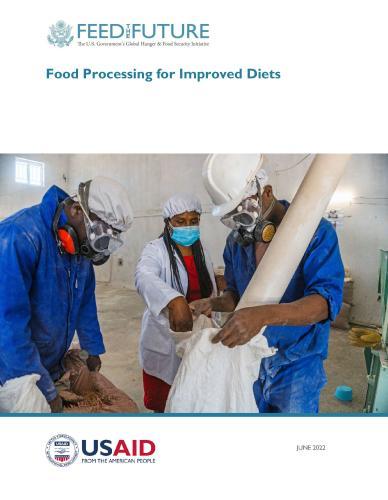
Technical Brief: Food Processing to Improve Diets
This technical brief helps USAID and its implementing partners design and implement food processing activities for improved diets and nutrition. The brief describes how food processing can improve diets, how it fits within USAID’s multi-sectoral food security and nutrition strategies, and what to consider when implementing food processing activities to improve diets and nutrition.
This resource also supports Food Environment.

Landscape Assessment: Food Processing in Feed the Future Investments
This landscape assessment helps USAID to better understand how food processing has been included in Feed the Future programming. It provides recommendations for improving food processing programming to increase year-round access to and consumption of foods that form part of a safe, nutritious diet.
This resource also relates to Investment Levers.
Food Environment
The food environment is where consumers directly procure food. We are working to better understand the characteristics of the food environment to help consumers make good food choices.
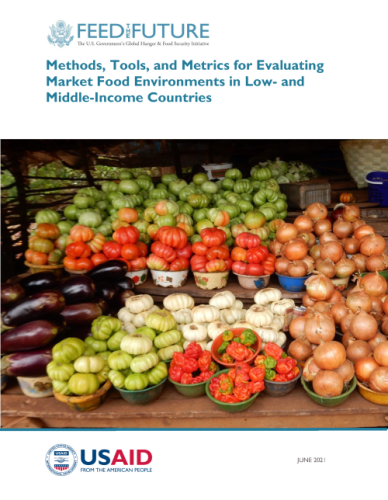
Methods, Tools, and Metrics for Evaluating Market Food Environments in Low- and Middle-Income Countries
This report presents findings from a landscape assessment, a ranking exercise, and a survey that led to a priority list of methods, tools, and metrics for evaluating informal and formal market food environments in low- and middle-income countries.

Food Environment Monitoring and Evaluation Guidance and Tools
This package helps global development partners working in low- and middle-income countries collect data that assesses the food environment. It includes documentation of a multi-year pilot study in Liberia, Honduras, Nigeria, and Timor-Leste that evaluated seven food environment assessments for their feasibility and acceptability, along with data collection tools that can be adapted to your context.

Generating Demand for Healthy Diets: Social Marketing Guide
This guide supports nutrition program planners by defining, describing, and explaining the process of developing high-quality programs to market healthy diets. The guide enables teams to make informed marketing decisions, create strong marketing campaigns, and diagnose and solve marketing challenges.

Suitability of Data-Collection Methods, Tools, and Metrics for Evaluating Market Food Environments in Low- and Middle-Income Countries
This open access article shares the findings from a study that evaluated the suitability of data-collection assessments (including methods, tools, and metrics) for multiple dimensions of the external and personal domains of market food environments in informal and formal markets in low- and middle-income countries.
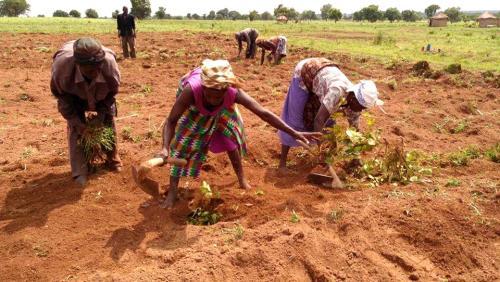
Nutrition-Sensitive Agricultural Interventions in Complex Emergencies
Women and children in complex emergencies are at high risk for malnutrition, poor health outcomes, and food insecurity. USAID Advancing Nutrition set out to better understand how nutrition-sensitive agriculture contributes to improved outcomes through research with two USAID activities, a qualitative and quantitative study in the Far North Region of Cameroon and a secondary data analysis in South Sudan.

Optimizing Diets by Using Local Foods for Improved Nutrition for Women and Children: A Guide for Resilience Food Security Activity Partners
This guide is for the United States Agency for International Development’s Bureau for Humanitarian Assistance-funded Resilience Food Security Activity (RFSA) Implementing Partners (IPs) and is intended for use by a multi-disciplinary RFSA team. It aims to support RFSA IPs’ transition from providing resource transfers to using locally available, accessible, and affordable alternatives to sustain nutrition outcomes for women and children under age two. It provides resources, workbooks, templates, and tools with instructions on how to optimize the use of local foods to improve women and children’s nutrition and dietary diversity in a given program area.
Food and Water Utilization
Food and water utilization is the ability of individuals to make use of the food and water they acquire.

Social and Behavior Change Resources for Women's Healthy Diets: 5 Gaps and Recommendations
This brief outlines gaps and recommendations in SBC resources for women's healthy diets. It first identifies quality SBC tools and resources through expert consultations and document reviews, and discusses which existing resources programs can adapt and use immediately.

Drivers
Drivers represent external forces that affect and may be affected by the food system in both positive and negative ways. They affect the ability of the food system to sustainably deliver safe, nutritious diets.
Drivers
Drivers represent external forces that affect and may be affected by the food system in both positive and negative ways. They affect the ability of the food system to sustainably deliver safe, nutritious diets.

Engaging Youth in Food Systems
This concept note describes evidence and opportunities for programmatic approaches to engage young people (between 10 to 29 years of age) in food systems activities for improved diet and nutrition outcomes.
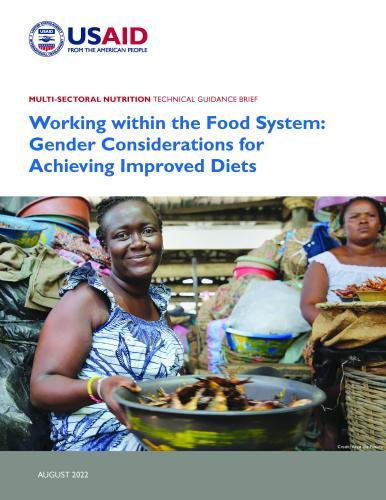
Working within the Food System: Gender Considerations for Achieving Improved Diets
This technical brief suggests how to take evidence-based actions that consider gender when designing and implementing approaches to improve diets through the food system. It offers ideas across the food system for promoting gender equality while improving diets.

Working Within the Food System: Agriculture-to-Nutrition Pathways for Achieving Improved Diets and Nutrition
The brief provides guidance on how to take evidence-based actions that consider the Agriculture-to-Nutrition Pathways when designing and implementing approaches to improve diets through food systems programming.

Illustrative Behaviors to Improve Nutrition-Sensitive Agriculture Tool
This tool provides a list of evidence-based nutrition-sensitive behaviors to spark ideas and discussion among activity designers and implementers. This list can help to identify nutrition-sensitive behaviors across the food system and food system actors to support an activity’s nutrition outcomes.
This resource also supports Food Supply, Food Environment, Food and Water Utilization, Investment Levers, and Development Outcomes.

Focusing on Social Norms: A Practical Guide for Nutrition Programmers to Improve Women’s and Children’s Diets
This guide includes tips and tools to improve program outcomes by understanding and responding to social norms at key points in the program cycle. It incorporates background on how to identify norms and monitor and measure normative change as well as helps to create enabling environments for greater and sustained change. It was updated in 2023 after user testing. It is for nutrition program planners and implementers planning norm-responsive activities within nutrition-sensitive or nutrition-specific programming.
This resource also supports Food and Water Utilization.

Investment Levers
Investment levers represent specific investments that affect both the food system and development outcomes. They are areas in which USAID and its partners can take action to affect food systems and development actions and catalyze change within food systems.
Investment Levers
Investment levers represent specific investments that affect both the food system and development outcomes. They are areas in which USAID and its partners can take action to affect food systems and development actions and catalyze change within food systems.

Food Systems and Nutrition E-Consultation Report
This report describes key findings and takeaways from a USAID e-consultation held in November 2019 with support from USAID Advancing Nutrition and Agrilinks. The e-consultation consisted of a webinar to share findings from an evidence review by the Feed the Future Innovation Lab for Nutrition at Tufts University.

Development Outcomes
Development outcomes are what we are trying to achieve through food systems actions. The primary outcome of food systems is diets. Secondary outcomes include income, health and nutrition, and environmental sustainability.
Development Outcomes
Development outcomes are what we are trying to achieve through food systems actions. The primary outcome of food systems is diets. Secondary outcomes include income, health and nutrition, and environmental sustainability.

Diet Assessment Decision Tool
This decision tool helps practitioners and decision makers understand dietary patterns and nutrient intake. It supports design, monitoring, and evaluation efforts to improve diets. It provides existing data sources and data collection tools related to five target groups.
This resource also supports Food and Water Utilization.

Assessing the Performance of National Sentinel Food Lists at Subnational Levels in Six Countries
Researchers analyzed data from seven surveys with 24-h open dietary recalls to assess how well national sentinel lists of the most frequently consumed foods in each food group capture data at subnational levels to measure minimum diet diversity. The study found that national sentinel food lists can provide reliable data at subnational levels for most food groups, with some variability by country and sub-region.

Where to Start?
When we identify ways to facilitate food systems change that improve outcomes related to quality of diets and nutrition, our programs are more likely to have sustained impact.
Where to Start?
When we identify ways to facilitate food systems change that improve outcomes related to quality of diets and nutrition, our programs are more likely to have sustained impact.
If your program is designed to improve the availability of selected crops, consider assessing the food environment to identify barriers and incentives that will ensure that increased availability will also lead to increased safe and nutritious food purchase and consumption.
Food Environment Monitoring and Evaluation: Guidance and Tools
If your program seeks to increase consumption of safe and nutritious foods, consider the most impactful demand generation strategies for your population of interest. Move beyond knowledge and awareness.
Generating Demand for Healthy Diets
If your program works on large-scale food fortification, consider barriers related to the legal and regulatory environment and opportunities to work with partner governments to encourage fortification activities.
Programs should be considerate of marginalized groups and how they engage with food systems.
Resources such as "Working within the Food System: Gender Considerations for Achieving Improved Diets" and "Engaging Youth in Food Systems" help guide conversations related to more inclusive (and effective) programming.
